|
BOURASSÉ M. J. J. - Publié Par M. MIGNE
DICTIONNAIRE D'ARCHEOLOGIE SACREE, contenant, par ordre alphabétique, des notions sûres et complètes sur les antiquités et les arts ecclésiastiques, savoir: l'architecture, la sculpture, la peinture, la mosaïque, les émaux, les vitraux peints,...
J.-P. Migne, Editeur - Petit-Montrouge Paris 1851 DICTIONNAIRE D'ARCHEOLOGIE SACREE, contenant, par ordre alphabétique, des notions sûres et complètes sur les antiquités et les arts ecclésiastiques, savoir: l'architecture, la sculpture, la peinture, la mosaïque, les émaux, les vitraux peints, l'orfèvrerie, la céramique, &., &., . suivi d'un résumé des caractères architectoniques., et d'un tableau méthodique.2 volumes in-4 ( 280 X 185 mm ) de 1304 colonnes ( 652 pages ): et 1168 colonnes ( 584 pages ), texte à 2 colonnes, demi-basane verte, dos lisses ornés de filets dorés. Figures hors-texte. "Nouvelle Encyclopédie Théologique. Tome Onzième et Douzième". Reliures frottées, rousseurs.
Referenz des Buchhändlers : 542242

|
|
|
LAVIGERIE Musée
Cahiers de Byrsa Volumes I à VII.
Imprimerie Nationale Paris 1951 7 volumes grand in-8 carré ( 270 X 215 mm ), brochés. Recherches, fouilles et études archéologiques de la Carthage punique, antique, et chrétienne par les plus grands spécialistes. Très nombreuses planches. Le musée Lavigerie se trouve à Carthage. Bel exemplaire.-Tome I: 307pp, nombreuses pl. de fig. et ill. phot. Couverture part. brunie, bon état. SOMMAIRE: Alfred MERLIN, Membre de l'Académie des Inscriptions et Belles-Lettres : Buste du Musée du Louvre provenant de Carthage - Magdeleine HOURS-MIEDAN, Assistante ( les Musées de France, Chef de laboratoire au Musée du Louvre : Les représentations figurées sur les stèles de Carthage - Pierre GANDOLPIIE , Membre de la Société française de Numismatique : A propos d'une monnaie du Musée de Constantine - R. P. FERRON , P. B., Directeur du Musée Lavigerie : Inscriptions juives de Carthage - .pigraphie romaine - Maurice PINARD, Chapiteaux byzantins de Numidie actuellement au Musée de Carthage - Pierre GARDOLPIIE : Saint-Louis de Carthage ( 1830-1950 ).-Tome II: 178pp., nombreuses planches dont 9 reprod. d'aquarelles en coul., planches ornées de reprod. de dessins et d'ill. photographiques. Bel ex. Sur quelques verreries de Bégram - Empreintes de sceaux égyptiens à Carthage - Milliaires de la route impériale Carthage-Théveste - Une effigie inédite de saint Augustin sur le sceau du duc byzantin de Numidie Pierre - Plaques de terre cuite préfabriquées d'époque byzantine découvertes à Carthage - Poteries et fragments chrétiens à décor incisé provenant de Carthage - Origines et débuts du Musée Lavignerie.- Tome III: 239pp., [1]f., nombreuses planches ornées de reprod. de dessins et d'ill.photographiques, dont 3 en couleurs. Bonne condition. Céramique archaique d'importation au Musée Lavigerie de Carthage - Numismatique des rois des Massyles ( 104-40 av. J.-C. ) - Vulgärpumsch und Vulgärlatein in den neupunischen Inschristen - Dédicace latine à Baal-Hammon - Matériaux pour servir à l'étude des verreries de Bégram - Un gazophylacium dans une antique citerne de Byrsa - Un groupe de tissus coptes d'époque musulmane - Etude et classement des lampes à huile musulmanes...- Tome IV: 183 pp, 48 planches pleine page dont 24 en couleurs.- Tome V: 281pp., nombreuses planches illustrées de reproductions photographiques et de figures d'après des dessins. Bel ex. Cylindres-sceaux orientaux trouvés à Carthage - Une statuette funéraire de Nechao II trouvée à Carthage - Les fouilles de Byrsa: 1953-1954 - Inscriptions des alentours de Mâreb ( Yemen ).- Tome VI: 201pp., [1]f., nombreuses planches illustrées de reproductions photographiques. Paralipomena Punica - Traditions funéraires de Carthage - Deux écritoires de la Diaspora africaine - Epigraphie juive - Un hypogée juif - Orfèvrerie musulmane - Un désastre nabatéen devant Nagran - Le pronom démonstratif sabéen mhn et les conjonctions composites lqbl( y )/d( t )kmhnmw et km'nmw - The origin of the Arabic Philosophical Term... - Tome VII: 217 pages . Les synagogues de la région de Djerba ( 25 planches photo et plan ), Cippe pour j. de Morgan, notes de glyptique orientale, les intailles orientales de la collection Henri de Genouillac ( 22 planches photo,120 pièces photographiées ) Paralipomena Punica ( suite ), Antiquités funéraires épigraphques qatabanites ( 4 planches ), les pierres épigraphiques qatabanites ( 2 planches ). L'article sur les synagogues de Djerba comprend une carte, 13 plans de synagogues, 11 planches photo.
Referenz des Buchhändlers : 130881

|
|
|
DAVEY Peter
THE ARCHAEOLOGY OF THE CLAY TOBACCO PIPES. I. Britain: The Midlands and Eastern England.
B.A.R. - British Archaeological Reports Oxford 1979 In-4 ( 295 X 210 mm ) de 411 pages, broché sous couverture imprimée. Nombreuses figures dans et hors-texte et planches photographiques hors-texte. Bel exemplaire.BAR British Series 63.
Referenz des Buchhändlers : 745531
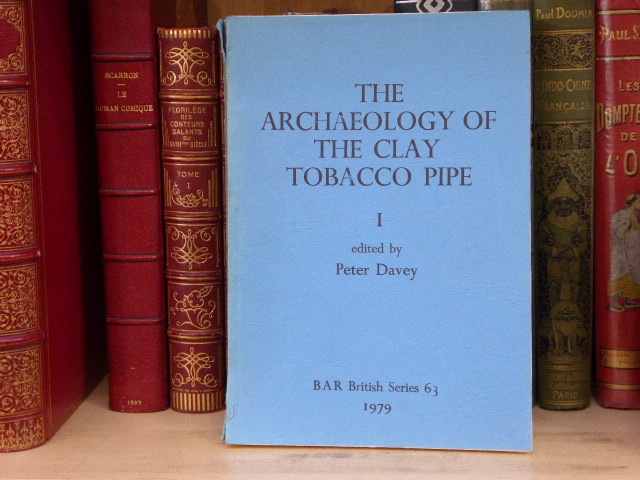
|
|
|
FABRE Augustin
Notice historique sur les anciennes rues de Marseille démolies en 1862 pour la création de la rue impériale.
Imprimerie Et Lithographie De Jules Barile Marseille 1862 In-8 ( 240 X 160 mm ) de 312 pages, demi-oasis chocolat à coins à la bradel, dos lisse titré en doré avec date dorée en queue, plats de papier-bois. Très bel exemplaire de l'édition originale imprimé sur beau papier, très bien relié.
Referenz des Buchhändlers : 119533
|
|
|
GAZIN Charles Lewis
A review of the upper Eocene Artiodactyla of North America ( Smithsonian miscellaneous collections V. 128, No. 8 ).
Smithsonian Institution Washington 1955 In-8 ( 245 X 160 mm ) de 112 pages, broché. 14 planches. Tampon gratté sur la couverture, bel exemplaire, non coupé.
Referenz des Buchhändlers : 990316
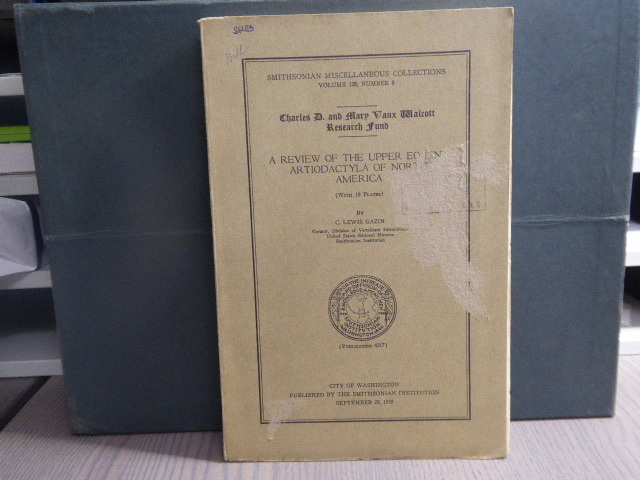
|
|
|
SAUTEL J.
les découvertes archéologiques de vaison-la-romaine de 1907 à 1937.
Rullière Avignon 1937 In-8 ( 210 X 135 mm ) de 73 pages, broché sous couverture illustrée. Illustrations dans et hors-texte. Bel exemplaire.
Referenz des Buchhändlers : 858569
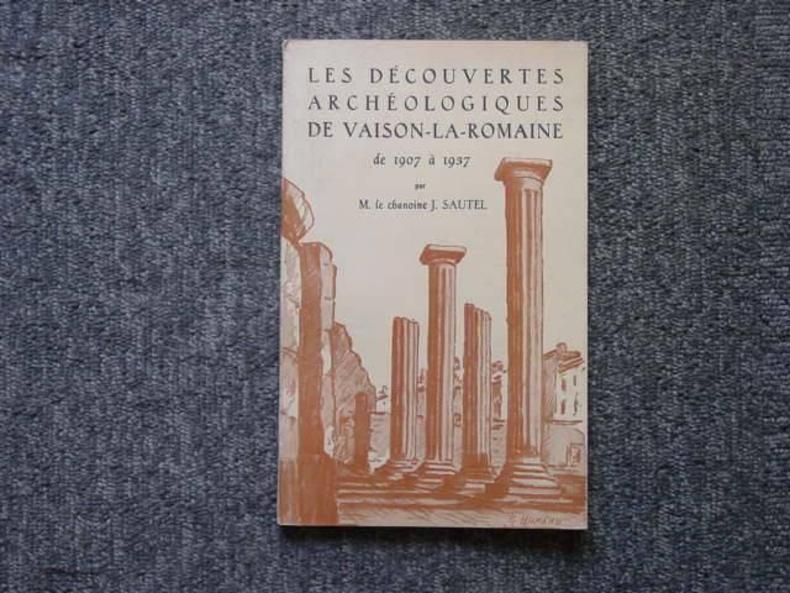
|
|
|
MARSEILLE ARCHEOLOGIE COLLECTIF
Le temps des découvertes. Marseille, de Protis à la reine Jeanne.
Musées De Marseille Marseille 1993 Plaquette in-4 ( 270 X 210 mm ) de 64 pages, agrafées. Nombreuses illustrations en couleurs et noir dans et hors-texte. Parfait état.
Referenz des Buchhändlers : 317051
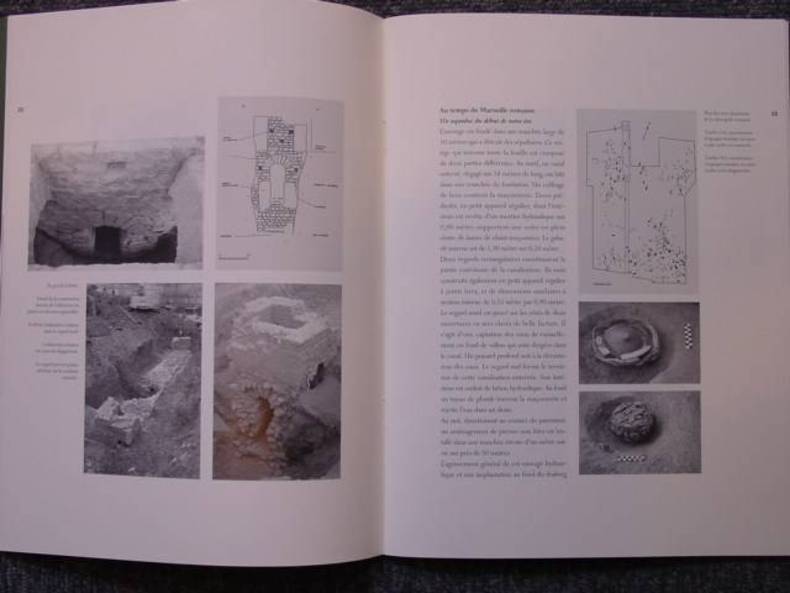
|
|
|
MINGQI
MINGQI d'époque MING.
S.N. S.L. (Chine) Epoque MING (136 Important MINGQI de 38 centimètres de hauteur, à engobe et rehauts de glaçure plombifère verte dite "sancai", représentant un dignitaire debout, la coiffe noire, la main gauche levée. Chine, Epoque MING ( 1368-1644 ). Très beau MINGQI avec une grande finesse de traits en parfait état. Moyennant la somme de 240,00 euros, nous pouvons fournir un test de thermoluminescence effectué dans un laboratoire agréé ( Laboratoire QED ) par un Expert près la Chambre Européenne des Experts-Conseils en Oeuvres d'Art attestant l'authenticité de cette terre cuite.
Referenz des Buchhändlers : 993289
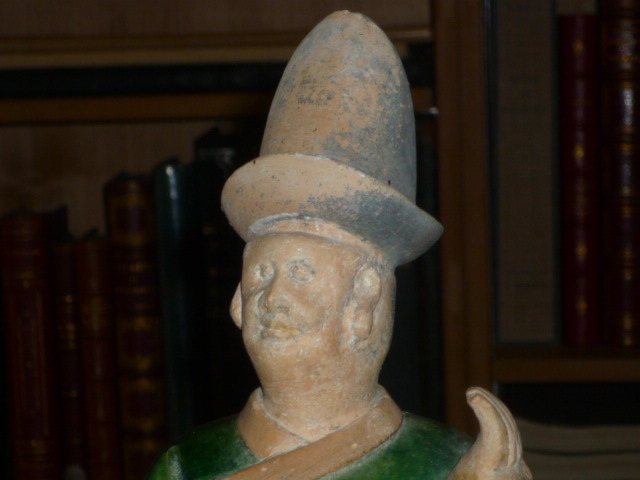
|
|
|
GROSSON J.B.B.
RECUEIL DES ANTIQUITES ET MONUMENS MARSEILLOIS qui peuvent intéresser l'Histoire et les Arts.
Chez Jean Mossy Marseille 1773 Petit in-4 ( 255 X 195 mm ) de 2 ff. n.ch. ( titre, approbation, errata ) 296 pages, reliure de lépoque pleine basane fauve, dos à nerfs orné de caissons de double filet doré fleuronnés, toutes tranches rouges. Edition originale illustrée de 47 planches gravées dépliantes, 42 d'entre elles réunissant un très grand nombre de monnaies, vestiges archéologiques, stèles, 2 vues, 1 plan et 5 planches non chiffrées regroupant 36 inscriptions d'épigraphies latines et grecques, gravées sur bois. Au bas de la plupart des planches gravées, on peut retrouver le nom des personnes les ayant financées.Seul ouvrage ancien donnant les monuments antiques de Marseille, les bas-reliefs, les monnaies. Ces gravures hors-texte sont l'uvre de l'artiste aixois Barthélémy LANTELME. GROSSON fut un grand antiquaire et son livre est fort précieux car il représente des antiques depuis lors disparus. A son époque déjà, le Comte MOSZYNSKI, célèbre voyageur polonais qui visita la Provence à la fin du XVIIIème siècle écrivait: "Je crois que sans G. GROSSON qui est non seulement amateur mais connaisseur érudit, ses concitoyens ignoreraient la plus grande partie des objets de ce genre que cette ville produit ou possède". Cet ouvrage est considéré "Comme une des plus belles éditions du XVIIIème en Provence" ( Billoud, 103 )."Coiffe supérieure absente, petites usures aux coins, BEL EXEMPLAIRE, peu commun.
Referenz des Buchhändlers : 542093
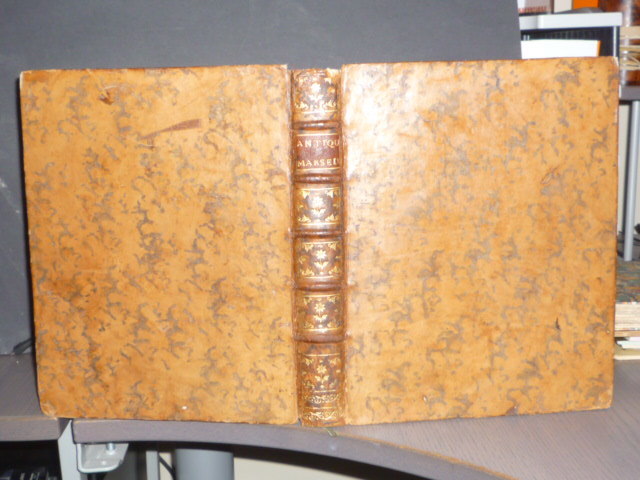
|
|
|
BROUSSAUD Général
Les Carreaux de faïence peints dans l'Afrique du Nord.
Librairie Plon Paris 1930 In-4 ( 315 X 235 mm ) en feuilles sous chemise cartonnée à dos de toile et fermeture à lacet. Collection du centenaire de l'Algérie 1830-1930 contenant 17 pages et 38 planches hors-texte, dont 15 en couleurs, reproduites au pochoir selon le procédé Jacomet, 2 en sépia, 2 en bleu et 19 en noir avec serpentes légendées ( indications d'origine et de dimensions ) reproduisant des carreaux provenant d'Alger, de Constantine, de Tunis. Rousseurs claires sur les pages de texte, bel exemplaire.
Referenz des Buchhändlers : 73473

|
|
|
HATT Jean-Jacques
LA TOMBE GALLO-ROMAINE. Recherches sur les inscriptions et les monuments funéraires gallo-romains des trois premiers siècles de notre ère.
Presses Universitaires De France Paris 1951 In-8 ( 255 X 165 mm ) de 329 pages, broché sous couverture imprimée. 11 cartes + VIII planches hors texte. EDITION ORIGINALE. Bel exemplaire.
Referenz des Buchhändlers : 833335
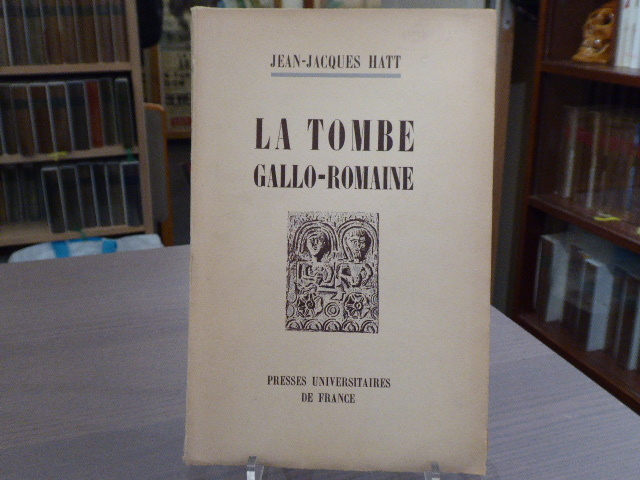
|
|
|
CAHIER Charles
Caractéristiques des saints dans l'art populaire, énumérées et expliquées. fascicule I. ( Avant-propos à Armoiries ).
Editions De Sancey Saint-Julien 1981 In-4 ( 330 X 240 mm ), des pages 1 à 85 ( pagination continue ), broché. Nombreuses illustrations dans le texte. Réimpression de l'édition de Poussielgue Frères, de 1867. Très bel exemplaire, en parfait état, de cette édition au tirage limité à 1000 exemplaires.
Referenz des Buchhändlers : 768029

|
|
|
DAVEY Peter - POGUE Dennis J.
THE ARCHAEOLOGY OF THE CLAY TOBACCO PIPES. XII. Chesapeake Bay.
B.A.R. - British Archaeological Reports Oxford 1991 In-4 ( 295 X 210 mm ) de 114 pages, broché sous couverture imprimée. Nombreuses figures dans et hors-texte et planches photographiques hors-texte. Bel exemplaire.Liverpool Monographs in Archeology and Oriental Studies N°.14BAR International Series 566.
Referenz des Buchhändlers : 57752

|
|
|
HART Gordon
Hart's Prehistoric Pipe Rack: Prehistoric Pipes of the Mississippi River Waterways - East.
Hart Publishers Bluffton, In. S.D. (1978) In-4 carré ( 280 X 215 mm ) de 272 pages, cartonnage de rexine caramel décoré de motifs dorés. Nombreuses illustrations dans le texte et planches hors-texte. Très bel exemplaire.
Referenz des Buchhändlers : 200293

|
|
|
TESSIER O. - SAMAT J.-B.
Marseille à travers les siècles.
Ludovic Baschet Paris S.D. (1899) V-257p.-( 6p. ). Pleine toile. Très riche iconographie. Bon état, intérieur frais, accident à la toile de la reliure.
Referenz des Buchhändlers : 84284
|
|
|
ROBIDA Albert
La vieille France: PROVENCE. Texte, dessins et lithographies par Albert ROBIDA.
Librairie Illustrée Paris S.D. (1890) Fort in-4 ( 315 X 235 mm ) de 332 pages demi-chagrin vert-sapin, dos à nerfs janséniste, couvertures illustrées et dos conservés. Beau livre illustré de 40 lithographies sous serpentes hors-texte et nombreux dessins dans le texte dessinés par ROBIDA. Très bel exemplaire, très pur, sans aucune rousseur.
Referenz des Buchhändlers : 884669
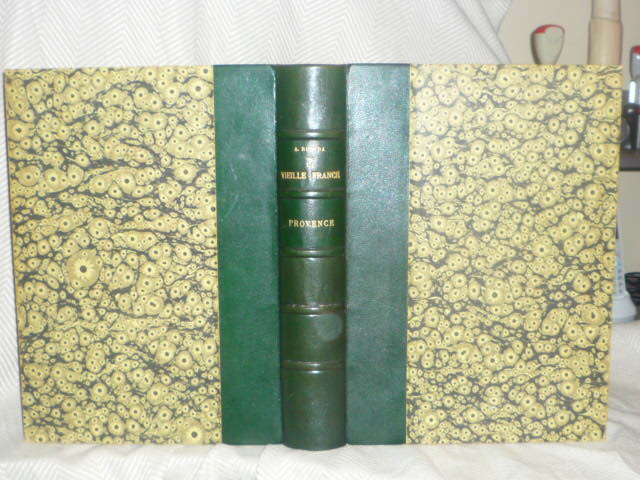
|
|
|
GRABAR André
L'ICONOCLASME BYZANTIN. Dossier Archeologique.
Collège De France Paris 1957 In-4 ( 280 X 205 mm ) de 275+27 pages, broché sous couverture imprimée. 27 planches hors texte comportant 163 sujets. EDITION ORIGINALE. Bel exemplaire.
Referenz des Buchhändlers : 506696

|
|
|
CAHIER Charles
Caractéristiques des saints dans l'art populaire, énumérées et expliquées. fascicule V. ( Enfants à Front marqué ).
Editions De Sancey Saint-Julien 1982 In-4 ( 330 X 240 mm ), des pages 348 à 437 ( pagination continue ), broché. Nombreuses illustrations dans le texte. Réimpression de l'édition de Poussielgue Frères, de 1867. Très bel exemplaire, en parfait état, de cette édition au tirage limité à 1000 exemplaires.
Referenz des Buchhändlers : 741865
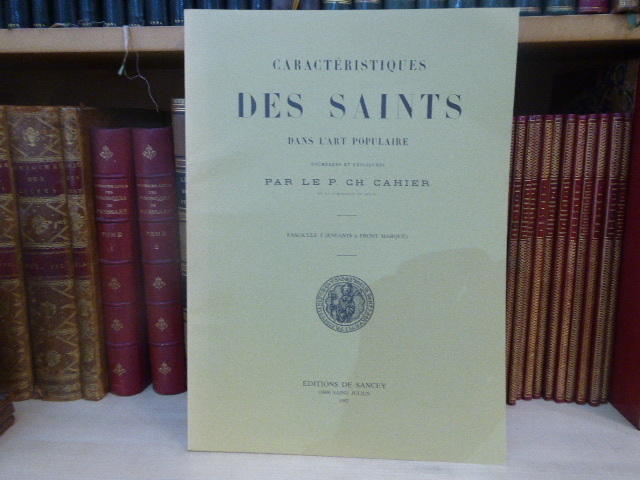
|
|
|
LINCKENHELD Emile
Les stèles funéraires en forme de maison chez les Médiomatriques et en Gaule.
Les Belles Lettres - Publications De La Faculté Des Lettres De L Université De Strasbourg Paris 1927 In-8 ( 255 X 170 mm ) de 159 pages, broché sous couverture imprimée. Ouvrage illustré de 30 figures et 4 planches dans le texte et de six planches hors texte. Dos insolé, bel exemplaire. ***
Referenz des Buchhändlers : 829229
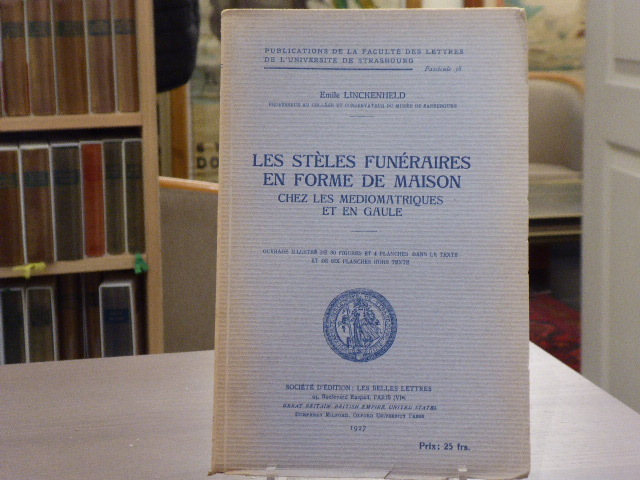
|
|
|
DOBLER Henri
Les Vestiges des Architectures et des Arts Décoratifs Provençaux aux XVII° et XVIII° siècles à Marseille.
Fernand Detaille Marseille 1913 Grand in-4 carré ( 325 X 255 mm ) de 188 pages, demi-basane noisette à coins, dos lisse orné de fleurons dorés, non rogné, couvertures conservées, armes de la Famille MAZUYER frappées à l'or au centre des plats: "dans un écu penché à dextre: d'azur au chevron d'or, accompagné en chef de deux étoiles du même et en pointe d'un croissant d'argent, est surmonté d'un casque et de ses lambrequins, avec un pélican avec sa piété pour cimier et une banderole où est inscrite la devise: Mihi non sum natus Ge ne suis pas né pour moi ). Très nombreuses illustrations dans et hors-texte de F. DETAILLE. Edition originale, 1 des 450 exemplaires numérotés sur beau vélin blanc ( N°348 ). Quelques rousseurs, bel exemplaire en reliure armoriée du plus rare des albums de Henri DOBLER.
Referenz des Buchhändlers : 109382

|
|
|
ROLLAND Henri
FOUILLES DE SAINT-BLAISE ( Bouches-du-Rhone ). Fouilles et Monuments Archeologiques En France Metropolitaine.
Centre National De La Recherche Scientifique Paris 1951 In-4 ( 285 X 230 mm ) de 290 pages, broché. 186 illustrations dans le texte, 2 cartes dépliantes. Bibliographie et index. Petite déchirure à la couverture sinon bel exemplaire.
Referenz des Buchhändlers : 683776

|
|
|
BENOIT Fernand
L'art primitif méditerranéen de la vallée du Rhône.
Editions Ophrys Gap 1955 Petit in-4 ( 255 X 190 mm ) de 71 pages, broché. 64 planches photographiques hors texte. Cartes et croquis in texte. Bel exemplaire.
Referenz des Buchhändlers : 386755
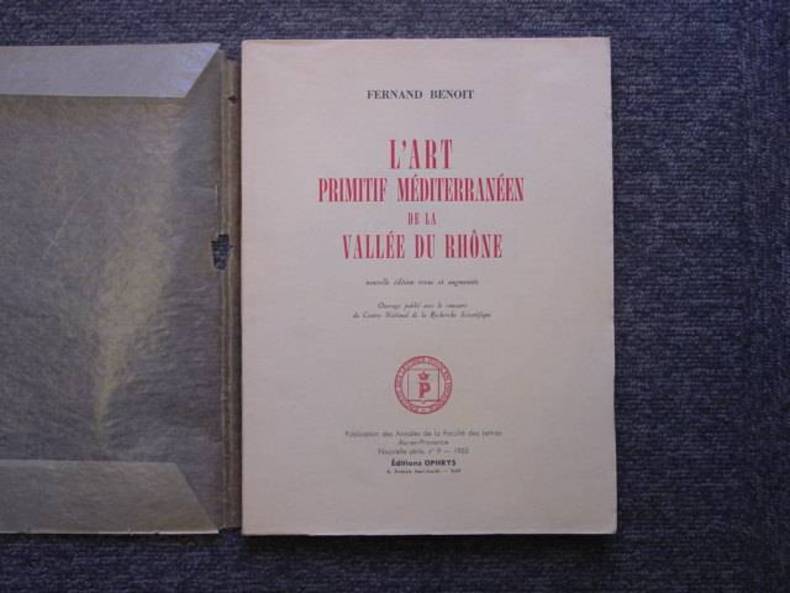
|
|
|
MAY Roland - DURAND Agnès - PIERINI Gisèle - TARIN Annie
JOUER DANS L'ANTIQUITE.
Réunion Des Musées Nationaux - Musée De Marseille Marseille 1991 In-4 ( 300 X 230 mm ) de 205 pages, broché sous couverture illustrée en couleurs rempliée. Catalogue de l'exposition présentée à Marseille du 22 novembre 1991 au 16 février 1992 au Musée d'Archéologie Méditerranéenne - Centre de la Vieille-Charité. Photographies en couleurs et en noir dans et hors-texte. Très bel exemplaire.
Referenz des Buchhändlers : 551218
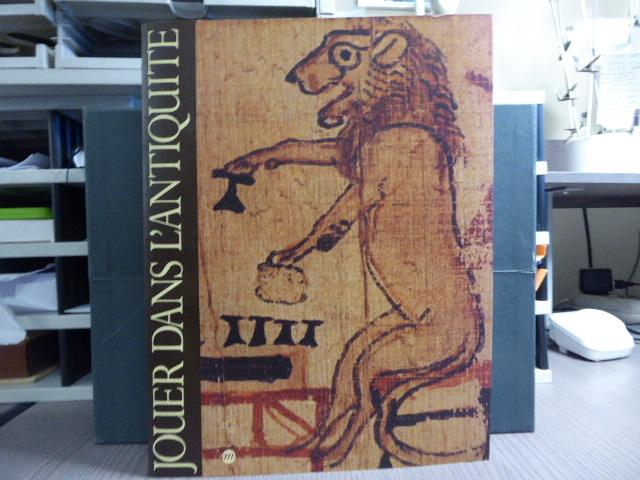
|
|
|
MARLES M. ( De )
Alfred, ou le jeune voyageur en France.
Didier Paris 1837 In-12 ( 180 X 110 mm ) de XI-372 pages, plein veau framboise, dos lisse orné d'un grand fer et de frises romantiques dorés, filet doré sur les plats encadrant un grand décor romantique estampé à froid, coupes et coiffes filetées d'or, tranches dorées. ( Reliure de l'époque ). 4 fines gravures hors-texte. Joli spécimen de reliure romantique.
Referenz des Buchhändlers : 885249
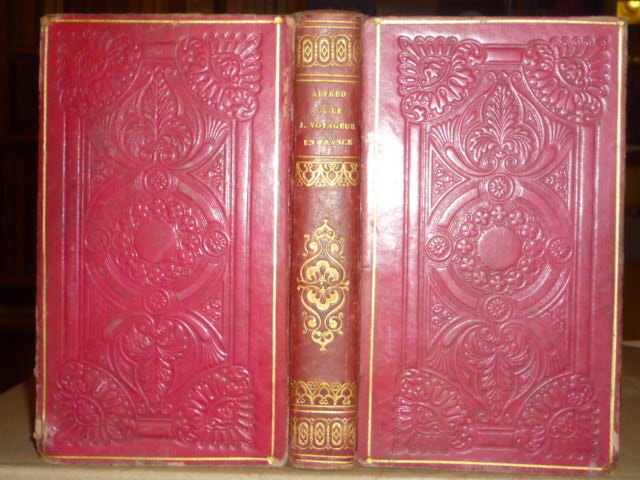
|
|
|
LENTHERIC Charles
L'ancien confluent du Rhône et de la Saône d'après les travaux de topographie & d'épigraphie modernes.
Imprimerie Clavel Et Chastanier Nimes 1886 In-8 ( 250 X 160 mm ) de 163 pages, broché sous couverture imprimée. Edition originale. Dos fendu, exemplaire non coupé.
Referenz des Buchhändlers : 861898
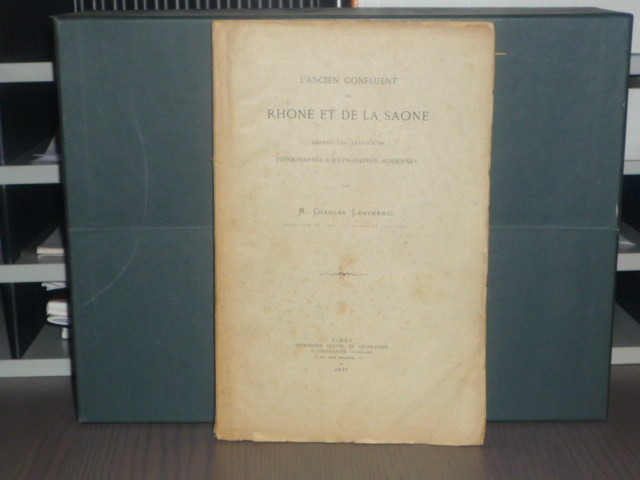
|
|
|
ROUSTAN François
LA MAJOR et LE PREMIER BAPTISTERE de MARSEILLE. Documents inédits sur l'architecture religieuse du Ve siècle.
Aubertin & Rolle Marseille 1905 Grand in-4 carré ( 285 X 225 mm ) de 63 pages, demi-chagrin rouge à coins, dos à nerfs orné de fleurons dorés, couverture et dos conservés. 15 aquarelles et 33 planches en phototypie. Ouvrage tiré à 200 exemplaires sur papier de luxe ( N°47 ). Très bel exemplaire.Documents inédits sur l'architecture religieuse du V° siècle. F. ROUSTAN, architecte du département et des monuments historiques du Var, est le dernier survivant de tous les architectes qui ont présidé ou collaboré à l'édification de la nouvelle cathédrale de Marseille et c'est lui seul qui possédait les éléments pour une étude complète de l'ancien édifice. Concernant ces dessins présentés dans l'ouvrage, ils furent exposés au salon de 1903 et obtinrent une médaille. Les notes et les croquis d'ESPERANDIEU sur la cathédrale ont été acquis par l'Etat français, de sorte que cet ouvrage constitue le seul document d'importance sur le sujet. L'auteur a consacré d'ailleurs vingt ans de recherches sur les lieux. L'ouvrage se compose de deux parties: une pour le baptistère, une pour la Major. Les planches ont été coloriées par l'auteur lui-même et sont autant de petits tableaux d'une grande délicatesse.
Referenz des Buchhändlers : 525424
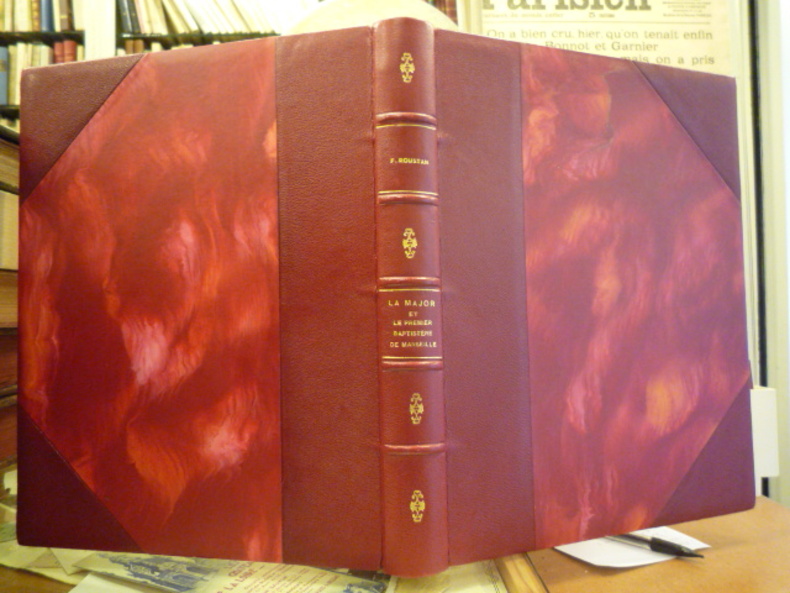
|
|
|
LENTHERIC Charles
Les voies antiques de la région du Rhône.
Seguin Frères, Imprimeurs-Editeurs Avignon 1882 In-8 ( 250 X 160 mm ) de 157 pages, broché sous couverture imprimée. Carte dépliante hors-texte. Edition originale. Petits manques au dos, bon exemplaire.
Referenz des Buchhändlers : 312167
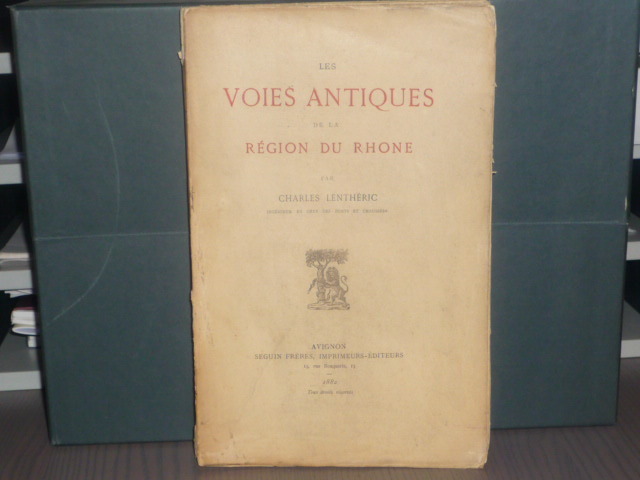
|
|
|
CAHIER Charles
Caractéristiques des saints dans l'art populaire, énumérées et expliquées. fascicule VI. ( Fruits à Livre ).
Editions De Sancey Saint-Julien 1982 In-4 ( 330 X 240 mm ), des pages 436 à 525 ( pagination continue ), broché. Nombreuses illustrations dans le texte. Réimpression de l'édition de Poussielgue Frères, de 1867. Très bel exemplaire, en parfait état, de cette édition au tirage limité à 1000 exemplaires.
Referenz des Buchhändlers : 234816
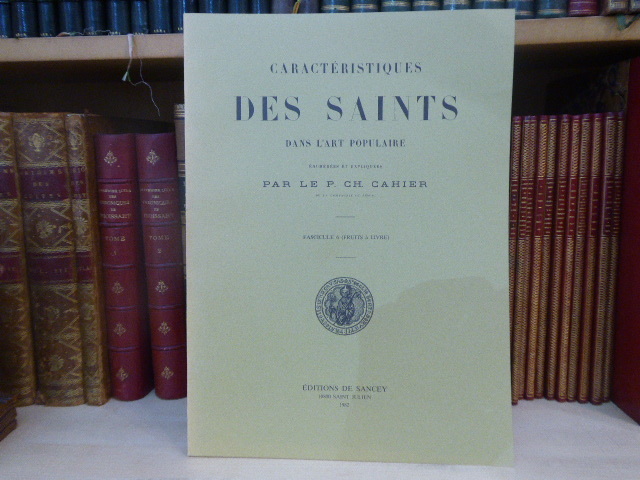
|
|
|
GUYS Pierre Augustin
Marseille ancienne et moderne.
Chez La Veuve Duchesne, Libraire Paris 1786 Petit in-8 ( 200 X 130 mm ) de 323 pages, reliure de lépoque plein veau porphyre, dos lisse fleuronnés, triple filet doré en encadrement des plats, pièce de titre en maroquin olive, roulette dorée sur coupes et chasses. EDITION ORIGINALE. Frottements et autres défauts néanmoins BON EXEMPLAIRE.
Referenz des Buchhändlers : 201760
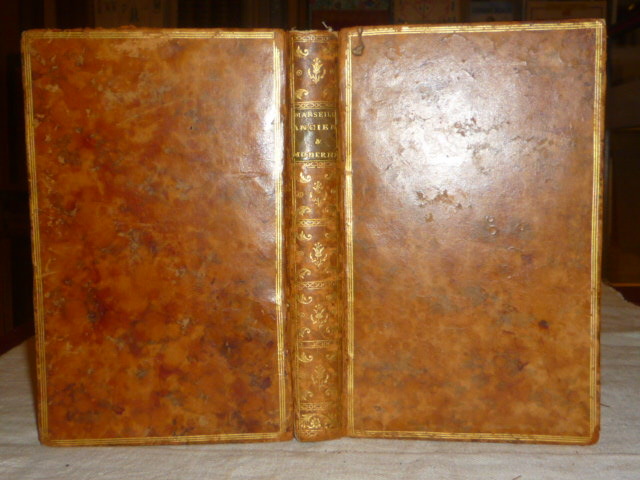
|
|
|
BESNIER Maurice
L'Ile Tibérine dans l'antiquité.
Albert Fontemoing, Editeur Paris 1902 In-8 ( 230 X 155 mm ) de IV-357 pages + Bibliographie, broché sous couverture imprimée. Frontispice en phototypie et 31 figures dans le texte. Couverture un peu ternie, bon exemplaire. Bibliothèque des Ecoles d'Athènes et de Rome, Fascicule 87. Table: Histoire de l'Ile Tibérine dans l'Antiquité - Les ponts de l'Ile Tibérine - Le Sancutaire d'Esculape ( Les origines du culte - L'arrivée du serpent d'Epidaure Le culte d'Esculape ) - Les cultes secondaires ( Jupiter, Jurarius et Vejovis Le temple de Faunus - Le sacellum de Tiberius. )
Referenz des Buchhändlers : 803930
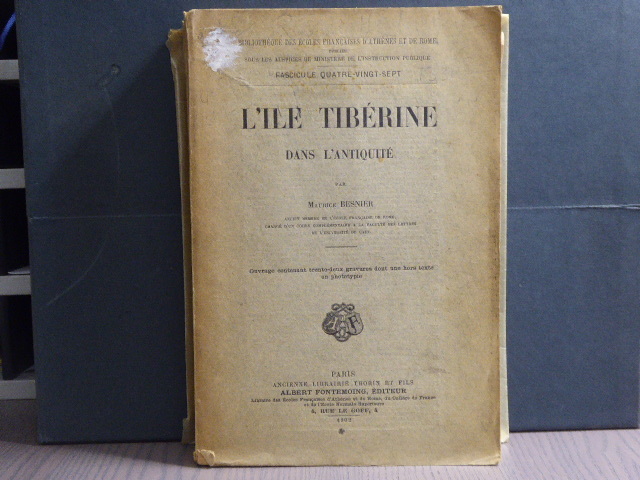
|
|
|
BOUILLET J.-B
Statistique monumentale du département duPuy-de-Dôme. Texte + Atlas.
Imprimerie De Perol Clermont-Ferrand 1846 1 volume in-8 ( 250 X 170 mm ) de VII-VIII-371 pages et 1 atlas in-4 oblong "à l'italienne" ( 265 X 415 mm ) de 7 pages et 34 planches ( dont une carte du Puy-de-Dôme et un plan de Clermont-Ferrand dépliants ). Demi chagrin cerise, dos à nerfs avec les armes dorées du Marquis DES ROYS en queue, tête dorée, couvertures conservées ( Reliure signée de LE DOUARIN ). Très bel exemplaire, très pur, sans taches ni rousseurs, de la bibliothèque du Marquis DES ROYS ( Ex-libris ).
Referenz des Buchhändlers : 462556

|
|
|
CLERC Michel
AQUAE SEXTIAE. Histoire d'Aix-en-Provence dans l'antiquité.
Laffitte Reprints Marseille 1973 In-8 ( 225 X 155 mm ) de 576 pages, plein skivertex maroquiné chocolat de l'éditeur, dos et plat supérieur titrés en lettres dorées. 42 planches hors-texte et 24 figures dans le texte. Réimpression en fac-similé de l'édition d'Aix-en-Provence 1916. Tirage limité à 250 exemplaires. Petites taches sur les tranches, bon exemplaire.
Referenz des Buchhändlers : 833013
|
|
|
ROUSTAN François
LA MAJOR et LE PREMIER BAPTISTERE de MARSEILLE. Documents inédits sur l'architecture religieuse du Ve siècle.
Aubertin & Rolle Marseille 1905 Grand in-4 carré ( 285 X 225 mm ) de 63 pages, demi-veau rouge, dos lisse avec date dorée en queue, couverture et dos conservés. 15 aquarelles et 33 planches en phototypie. Ouvrage tiré à 200 exemplaires sur papier de luxe ( N°50 ). Très bel exemplaire. Documents inédits sur l'architecture religieuse du V° siècle.F. ROUSTAN, architecte du département et des monuments historiques du Var, est le dernier survivant de tous les architectes qui ont présidé ou collaboré à l'édification de la nouvelle cathédrale de Marseille et c'est lui seul qui possédait les éléments pour une étude complète de l'ancien édifice. Concernant ces dessins présentés dans l'ouvrage, ils furent exposés au salon de 1903 et obtinrent une médaille. Les notes et les croquis d'ESPERANDIEU sur la cathédrale ont été acquis par l'Etat français, de sorte que cet ouvrage constitue le seul document d'importance sur le sujet. L'auteur a consacré d'ailleurs vingt ans de recherches sur les lieux. L'ouvrage se compose de deux parties: une pour le baptistère, une pour la Major. Les planches ont été coloriées par l'auteur lui-même et sont autant de petits tableaux d'une grande délicatesse.
Referenz des Buchhändlers : 511405
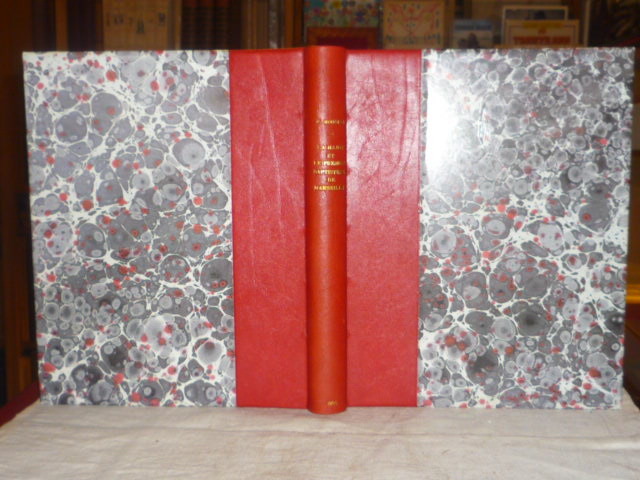
|
|
|
DAVEY Peter
THE ARCHAEOLOGY OF THE CLAY TOBACCO PIPES. VIII. America.
B.A.R. - British Archaeological Reports Oxford 1983 In-4 ( 295 X 210 mm ) de 286 pages, broché sous couverture imprimée. Nombreuses figures dans et hors-texte et planches photographiques hors-texte. Bel exemplaire.BAR International Series 175.
Referenz des Buchhändlers : 244479

|
|
|
BRANCHE Dominique - THIBAUD Emile
L'AUVERGNE au Moyen âge. Avec un atlas de planches, par M. Émile THIBAUD. - ATLAS pour L'AUVERGNE au Moyen Age. Les Monastères. Histoire des ordres monastiques en Auvergne. Texte + Atlas.
Thibaud-Landriot - Pelissonnier Clermont-Ferrand - Paris 1842 1 volume in-8 ( 235 X 150 mm ) de XVI-540 pages et 1 atlas in-folio ( 470 X 330 mm ) de 3 feuillets et 20 planches montées sur onglets ( vues d'édifices, plans et blasons dont certaines lithographiées sur Chine... ). Demi basane fauve, dos lisses ornés de filets dorés avec les armes dorées du Marquis DES ROYS en queue. EDITION ORIGINALE TRES RARE AVEC L'ATLAS. Dos éclaircis, petites épidermures, bel exemplaire, très pur, sans taches ni rousseurs, de la bibliothèque du Marquis DES ROYS ( Ex-libris ).
Referenz des Buchhändlers : 862290

|
|
|
GROSSON J.B.B.
RECUEIL DES ANTIQUITES ET MONUMENS MARSEILLOIS qui peuvent intéresser l'Histoire et les Arts.
Chez Jean Mossy Marseille 1773 Petit in-4 ( 255 X 195 mm ) de 2 ff. n.ch. ( titre, approbation, errata ) 296 pages, demi-basane verte, dos lisse orné de filets dorés, tranches mouchetées ( Reliure postérieure ). Edition originale illustrée de 47 planches gravées dépliantes, 42 d'entre elles réunissant un très grand nombre de monnaies, vestiges archéologiques, stèles, 2 vues, 1 plan et 5 planches non chiffrées regroupant 36 inscriptions d'épigraphies latines et grecques, gravées sur bois. Au bas de la plupart des planches gravées, on peut retrouver le nom des personnes les ayant financées.Seul ouvrage ancien donnant les monuments antiques de Marseille, les bas-reliefs, les monnaies. Ces gravures hors-texte sont l'uvre de l'artiste aixois Barthélémy LANTELME. GROSSON fut un grand antiquaire et son livre est fort précieux car il représente des antiques depuis lors disparus. A son époque déjà, le Comte MOSZYNSKI, célèbre voyageur polonais qui visita la Provence à la fin du XVIIIème siècle écrivait: "Je crois que sans G. GROSSON qui est non seulement amateur mais connaisseur érudit, ses concitoyens ignoreraient la plus grande partie des objets de ce genre que cette ville produit ou possède". Cet ouvrage est considéré "Comme une des plus belles éditions du XVIIIème en Provence" ( Billoud, 103 )."Reliure légèrement frottée, BEL EXEMPLAIRE, peu commun.
Referenz des Buchhändlers : 639442
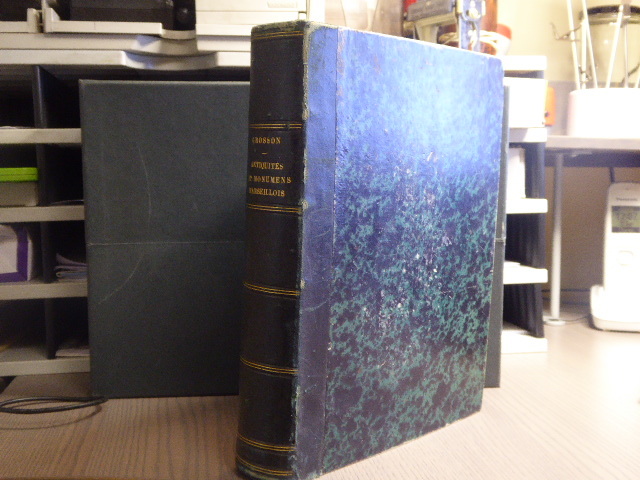
|
|
|
SAUREL Alfred - POUILLET L.
Dictionnaire des villes, villages et hameaux du département des Bouches-du-Rhône. 2 Tomes.
Typographie Et Lithographie Marius Olive Marseille 1877-1878 2 volumes grand in-8 ( 245 X 160 mm ) de 8 feuillets non chiffrés ( faux-titre, titre, dédicace, liste des souscripteurs, avant-propos, introduction ) 2-389 pages et 3 feuillets non chiffrés ( faux-titre, titre, avant-propos ) 8-446 pages, demi-maroquin à coins vert lierre, dos à nerfs richement orné de caissons et fleurons dorés, têtes dorées ( Reliures signées de L. POUYILLET ). 1 plan replié de Marseille, 2 cartes dépliantes ( Banlieu de Marseille - Département des Bouches-du-Rhône ), 12 planches gravées hors-texte. EDITION ORIGINALE très rare. Très bel exemplaire, imprimé sur Hollande, bien relié.
Referenz des Buchhändlers : 195753
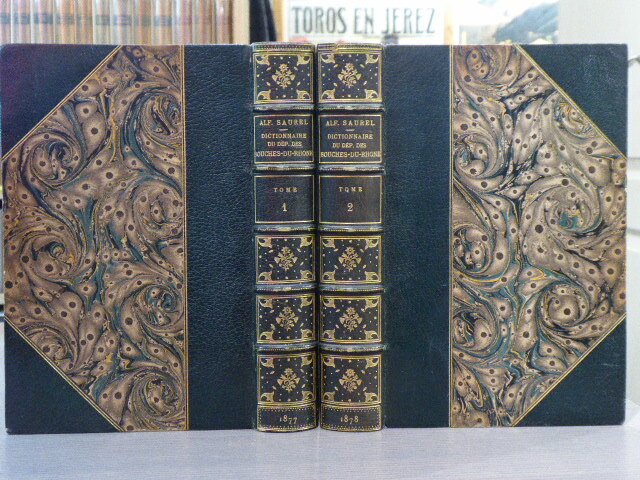
|
|
|
CAHIER Charles
Caractéristiques des saints dans l'art populaire, énumérées et expliquées. fascicule III. ( Calice à Costumes ).
Editions De Sancey Saint-Julien 1981 In-4 ( 330 X 240 mm ), des pages 172 à 261 ( pagination continue ), broché. Nombreuses illustrations dans le texte. Réimpression de l'édition de Poussielgue Frères, de 1867. Très bel exemplaire, en parfait état, de cette édition au tirage limité à 1000 exemplaires.
Referenz des Buchhändlers : 600179

|
|
|
KERCHACHE Jacques [sous La Direction De]
L'ART TAÏNO - L'art des sculpteurs Taïnos, chefs-d'oeuvre des Grandes Antilles précolombiennes.
Paris Musées Paris 1994 In-4 carré ( 295 X 295 mm ) de 269 pages, broché sous couverture illustrée en couleurs rempliée. Superbe et abondante iconographie en couleurs et en noir dans et hors-texte. Catalogue de l'expédition qui s'est tenue du 24 Février au 29 Mai 1994, au Musée du Petit Palais. Très bel exemplaire en superbe état.Les artistes taïnos ont produit des formes d'une identité tout à fait originale équivalant aux grands oeuvres olmèques, mayas, aztèques, révélant une étrange similitude avec l'esthétique de l'ile de pâques et de Hawaï. Ils s'inscrivent ainsi au premier rang du patrimoine culturel de l'humanité. Cet ouvrage réunit près de cent chefs-d'oeuvre de l'art des Indiens taïnos, appartenant aux plus grands musées du monde, et cela pour la première fois depuis la découverte de l'Amérique par Christophe Colomb. Ces Indiens Taïnos avec lesquels Christophe Colomb est entré en contact en 1492 à Saint-Domingue, Haïti, Puerto Rico, Cuba et la Jamaïque sont encore pratiquement inconnus de public éclairé. Ils avaient constitué une société de loisirs, sans état mais structurée, et vivaient de l'agriculture, de la pêche et de la chasse. Ils étaient environ un million au moment de la conquête espagnole. Dix ans plus tard, on n'en comptait plus que dix mille. Les massacres, les maladies et le travail forcé avaient entrainé des suicides collectifs considérables.
Referenz des Buchhändlers : 926578
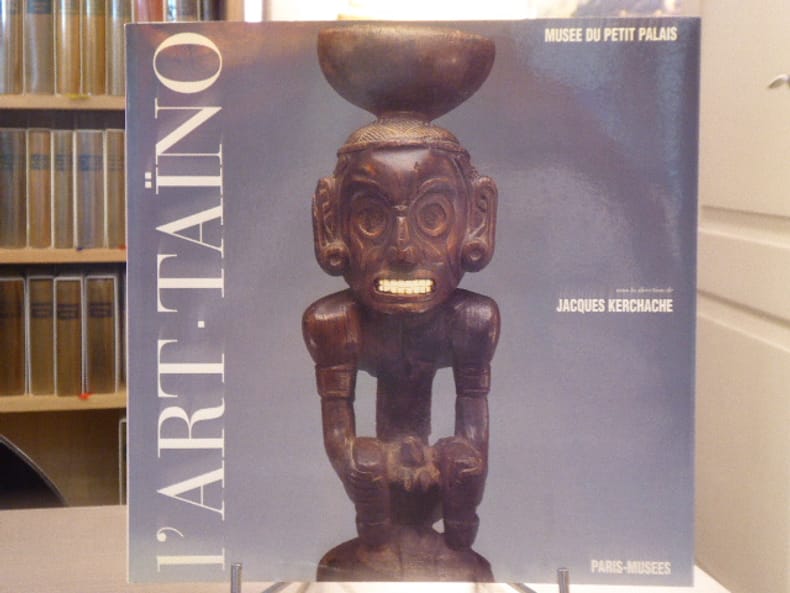
|
|
|
CAHIER Charles
Caractéristiques des saints dans l'art populaire, énumérées et expliquées. fascicule VII. ( Livre à Patrons divers ).
Editions De Sancey Saint-Julien 1982 In-4 ( 330 X 240 mm ), des pages 524 à 613 ( pagination continue ), broché. Nombreuses illustrations dans le texte. Réimpression de l'édition de Poussielgue Frères, de 1867. Très bel exemplaire, en parfait état, de cette édition au tirage limité à 1000 exemplaires.
Referenz des Buchhändlers : 659245
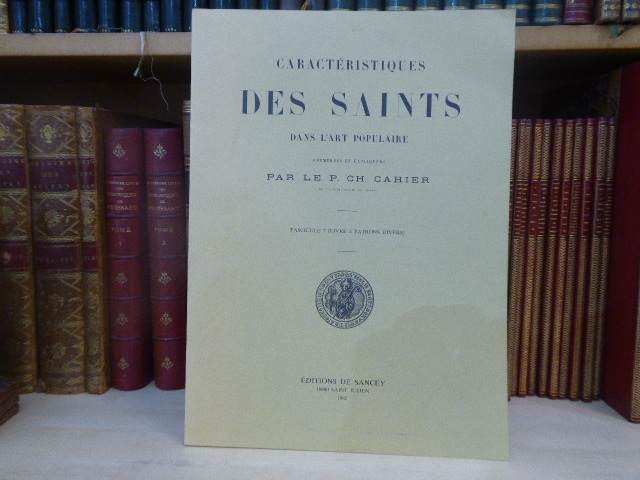
|
|
|
MINGQI
MINGQI d'époque MING.
S.N. S.L. (Chine) Epoque MING (136 Important MINGQI en terre-cuite de 38 centimètres de hauteur, à engobe et rehauts de glaçure plombifère verte dite "sancai", représentant un dignitaire debout, la coiffe noire, la main droite sur le torse. Chine, Epoque MING ( 1368-1644 ). Très beau MINGQI avec une grande finesse de traits en parfait état. Authenticité de cette terre-cuite attestée par un test de thermoluminescence effectué dans un laboratoire agréé ( Laboratoire QED ) par un Expert près la Chambre Européenne des Experts-Conseils en Oeuvres d'Art ( certificat joint ).
Referenz des Buchhändlers : 245323
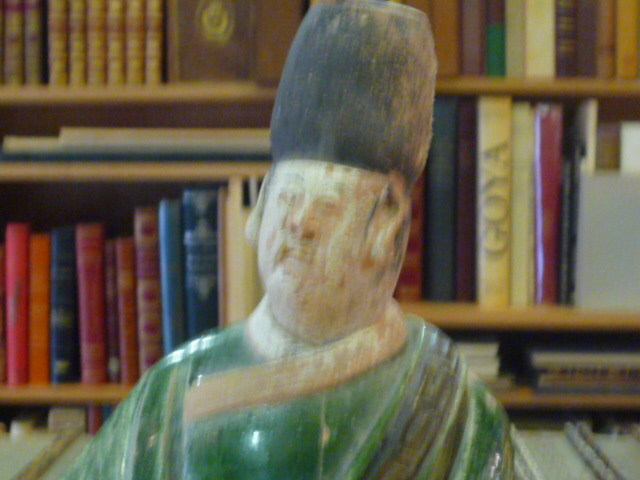
|
|
|
DAVEY Peter
THE ARCHAEOLOGY OF THE CLAY TOBACCO PIPES. III. Britain: The North and West.
B.A.R. - British Archaeological Reports Oxford 1980 In-4 ( 295 X 210 mm ) de 391 pages, broché sous couverture imprimée. Nombreuses figures dans et hors-texte et planches photographiques hors-texte. Bel exemplaire.BAR British Series 78.
Referenz des Buchhändlers : 244301
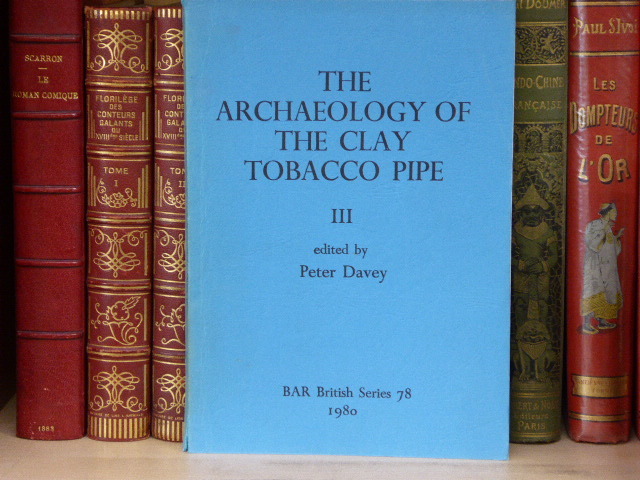
|
|
|
MINGQI
MINGQI d'époque MING.
S.N. S.L. (Chine) Epoque MING (136 Important MINGQI en terre cuite de 38 centimètres de hauteur, à engobe et rehauts de glaçure plombifère anthracite dite "sancai", représentant un dignitaire debout, la coiffe noire, la main gauche ouverte sur le ventre. Epoque MING ( 1368-1644 ). Très beau MINGQI avec une grande finesse de traits en parfait état. Moyennant la somme de 240,00 euros, nous pouvons fournir un test de thermoluminescence effectué dans un laboratoire agréé ( Laboratoire QED ) par un Expert près la Chambre Européenne des Experts-Conseils en Oeuvres d'Art attestant l'authenticité de cette terre cuite.
Referenz des Buchhändlers : 96521
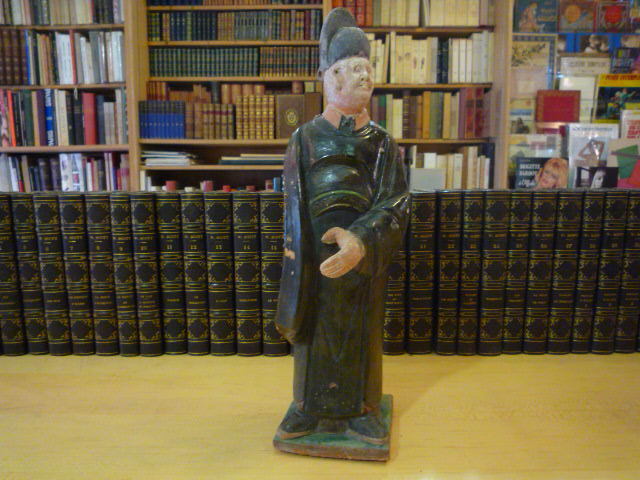
|
|
|
PASSET Claude
La Passion de PONS DE CIMIEZ ( Passio Pontii ). Sources et tradition.
Belisane Nice 1977 3 ouvrages reliés en 1 volume in-4 ( 295 X 225 mm ), demi-basane caramel à coins, dos à nerfs janséniste avec étiquette de titre, couvertures conservées. Très bel exemplaire de cette rare réunion. De la bibliothèque Gilbert TAPPA ( Ex-Libris ).- Les sources manuscrites de La Passio de PONS DE CIMIEZ. Texte latin et traduction française. Les fragments carolingiens de l'Abbaye de Saint-Pons. Etude et interprétation. Edition de nombreux manuscrits inédits. 300 pages. 20 planches et une carte dépliante hors-texte.- Claude PASSET: Les sources de la "Passio devotae" un manuscrit inédit. Paris, B.N., LAT. 5248 ( XIIe siècle ). Paginé 79 à 98. 4 planches hors-texte.- Giordani Roberto: RECENSIONI. Paginé 270 à 304.
Referenz des Buchhändlers : 846088
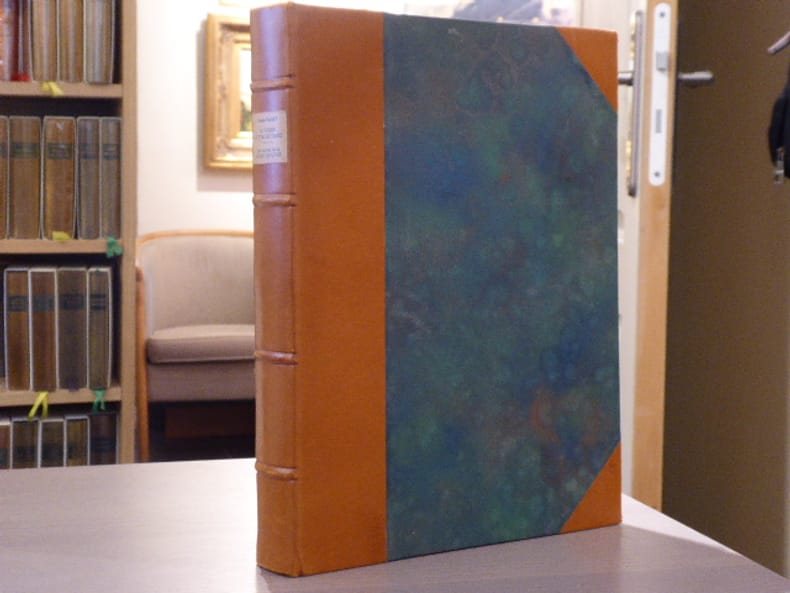
|
|
|
LOPEZ COLOM Maria Del Mar
Coleccion Hurbil 1. PIPAS DE ARCILLA HALLADAS EN GIPUZKOA. APROXIMACION A SU CATALOGACION ARQUEOLOGICA Y TIPOLOGICA.
Arkeolan Irun 1996 In-4 carré ( 265 X 240 mm ) de XI-403 pages, broché sous couverture illustrée. Figures dans le texte et planches hors-texte. Très bel exemplaire.
Referenz des Buchhändlers : 915855

|
|
|
MILLOUE L. ( De )
Conférences au Musée GUIMET. 1903-04, 1904-05 et 1905-06.
Leroux Paris 1907 In-8 ( 190 X 130 mm ) de 181 pages, broché sous couverture imprimée. Couverture salie.
Referenz des Buchhändlers : 636588
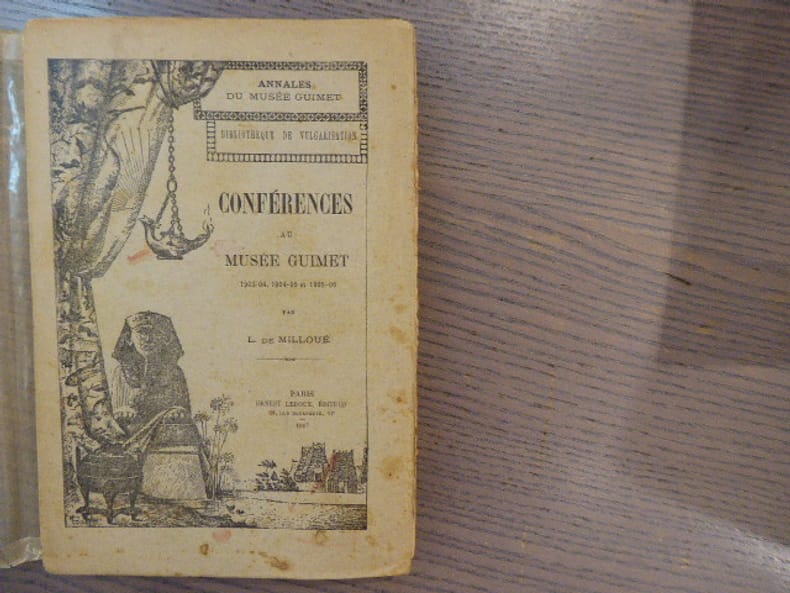
|
|
|
MONGEZ M. L'aîné - DIDEROT - D'ALEMBERT
ENCYCLOPEDIE METHODIQUE. DICTIONNAIRE d'Antiquités, de Mythologie, de Diplomatique des Chartres et Chronologie. ( 5 volumes, série complète ).
Chez Panckoucke - Chez Plomteux - Chez H. Agasse Paris 1786-1792 5 volumes in-4 carré ( 265 X 205 mm ), plein veau fauve granité glacé, dos lisses ornés de fleurons et caissons dorés, pièces de titre de basane grenat et de tomaison de basane olive ( Reliures de l'époque ). Coiffes légèrement frottées bel exemplaire, pur dans des reliures décoratives.
Referenz des Buchhändlers : 720988
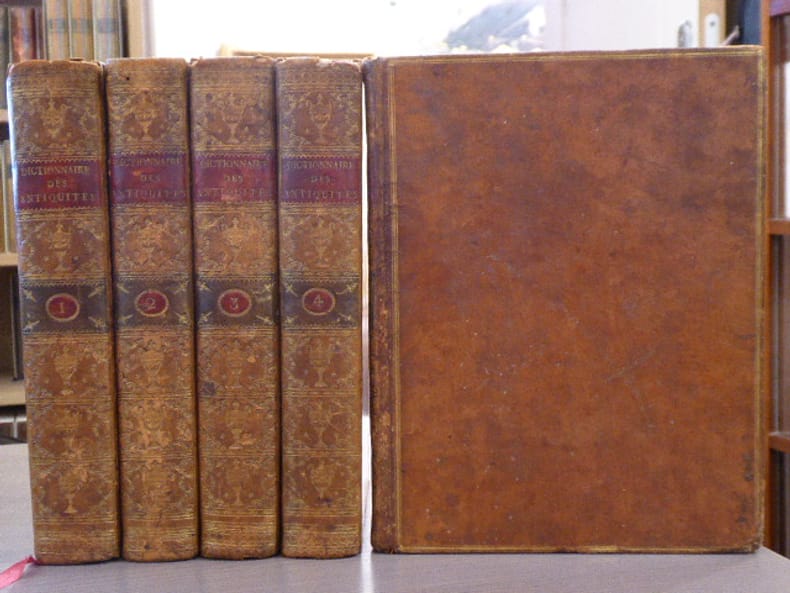
|
|
|
LE ROUZIC Z.
CARNAC. Restaurations faites dans la région. Les Cromlechs de Er-Lannic. Commune d'Arzon de 1923-1926.
Imprimerie Lafolye & J. De Lamarzelle Vannes 1930 In-8 ( 265 X 220 mm ) de 37 pages, broché sous couverture illustrée. Planches hors-texte. Bel exemplaire.
Referenz des Buchhändlers : 591913

|
|
|
CLERC Michel
MASSALIA. Histoire de Marseille dans l'Antiquité des origines à la fin de l'Empire Romain d'Occident ( 476 après J.C. ). 2 volumes. ( Ouvrage complet ).
Laffitte Reprints Marseille 1999 2 volumes in-4 ( 310 X 225 mm ) de 480 et 489 pages, plein skivertex chocolat, dos lisses ornés d'un fleuron doré, plats titrés en lettres dorées ( Reliure de l'éditeur ). Illustrations et plans dépliants. Tome I. Des origines jusqu'au IIIe siècle avant J. C. Tome II. Réimpression en fac-similé de l'édition de Marseille 1927-1929. Exemplaire numéroté ( N°1 ). Très bel exemplaire.
Referenz des Buchhändlers : 824027
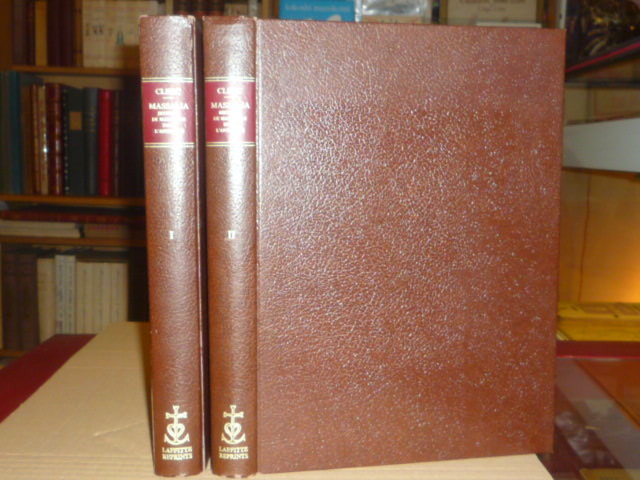
|
|
|
ALDRED Cyril - BARGUET Paul - DESROCHES-NOBLECOURT Christiane
Le Monde Egyptiens. LES PHARAONS. l'EMPIRE DES CONQUERANTS. l’ Egypte au Nouvel Empire ( 1560-1070 ).
Gallimard NRF "L Paris 1979 In-4 carré ( 280 X 220 mm ) de 337 pages, pleine toile rouge sous jaquette illustrée en couleurs et étui. Superbe et abondante iconographie dans et hors-texte en couleurs et en noir, cartes et documentation, certaines en dépliant. Très bel exemplaire.
Referenz des Buchhändlers : 702880

|
|